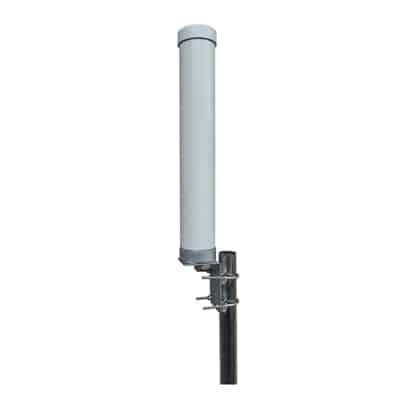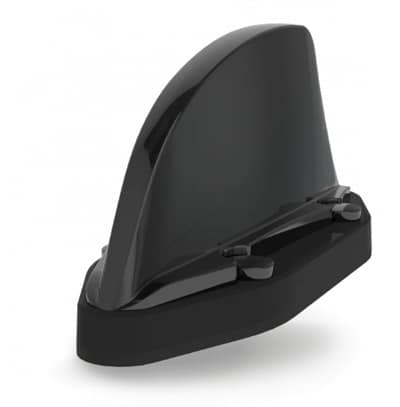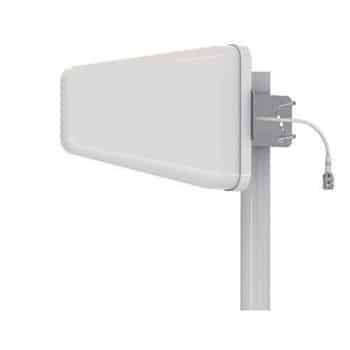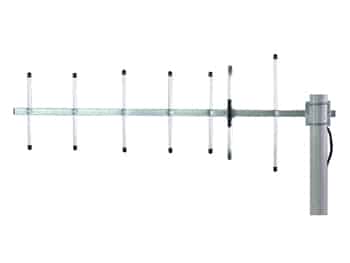
In order to cover the increasing demand for modern networking, dual band WiFi antennas have made the wireless connectivity possible by providing faster speeds, more stability, and wider coverage. Dual-band antennas outperform conventional single-band antennas by using both the 2.4 GHz and 5 GHz frequency bands, while maximizing performance for everything from gaming and streaming to large-scale business operations. This article explains the fundamentals of dual-band Wi-Fi antennas, covering everything from their different types, uses, and advantages to their basic characteristics and performance. We’ll discuss antenna specifications, explain the differences between single-band and dual-band selection, and help you select the ideal dual-band antenna for your requirements.
Table of Contents
ToggleWhat is Dual-Band Wi-Fi?
Dual band Wi-Fi is a term used for wireless networking that simultaneously uses the 2.4 GHz and 5 GHz bands. Traditional Wi-Fi networks typically use the 2.4 GHz frequency spectrum. However, with the introduction of dual band routers and devices, the 5 GHz band became available to provide greater network capacity and improved performance.
The wireless standards for 2.4GHz (802.11b) and 5GHz (802.11a) were established as part of the evolution of the 802.11 standards to address emerging connectivity needs. The 2.4 GHz led Wi-Fi networks to slow down and become clogged where all wireless devices, including laptops and Bluetooth headphones, use the same frequency. As a result, manufacturers began producing devices that complied with the 802.11a (5GHz) standard. To make it easier to connect to 2.4Ghz Wi-Fi networks, devices with dual-band capabilities were made available.
2.4 GHz Frequency: The 2.4 GHz band has been widely used in connectivity due to its long-range coverage and wide device compatibility. However, some other devices, such as microwaves, Bluetooth devices, and cordless phones, share this same frequency range. This led to interference and poor performance in places with a lot of wireless devices.
5 GHz Frequency: These limitations were overcome with the introduction of the 5 GHz Wi-Fi band. It provides faster data transfer speeds, less open channels, and reduced device interference. By simultaneously using the 2.4 GHz and 5 GHz bands, dual band Wi-Fi allows devices to choose the frequency band that provides the best performance with minimal interference.
The biggest difference between the two systems is that single-band networks use just one frequency (2.4 GHz) while dual-band networks can operate on two (2.4 GHz and 5 GHz). Although single-band Wi-Fi has a longer range, it functions slower. It is perfect for low-bandwidth tasks like emailing, watching movies, and web browsing. Single-band Wi-Fi is more prone to interference, even if it has a wider coverage area. Dual-band Wi-Fi, which operates at two speeds, provides a faster and reliable connection but has a limited range. Most importantly, it can manage multiple users and devices. Dual-band Wi-Fi is therefore perfect for larger houses and families that want to play online games and stream videos.
Now, lets discuss some differences of single band and dual-band WiFi Antennas,
Dual-band WiFi antennas offer several advantages over single-band alternatives. While single-band antennas operate solely on the 2.4 GHz frequency, dual-band antennas utilize both 2.4 GHz and 5 GHz frequencies. This allows faster speeds as network traffic can be distributed across the two bands. Additionally, they reduce interference from other devices, which commonly congest the 2.4 GHz band. Dual-band antennas also perform better in crowded areas, making them ideal for bandwidth-intensive activities like streaming and gaming. They can accommodate multiple devices simultaneously without significant performance degradation. Furthermore, they are designed for easy setup and management, often with intuitive apps or web interfaces. With backward compatibility for older wireless devices and better signal strength, dual-band WiFi antennas provide a more stable and efficient connection compared to single-band options.
What do dual-band WiFi antennas do
A dual-band Wi-Fi antenna allows a device to connect to both the 2.4 GHz and 5 GHz frequency bands of a Wi-Fi network. In addition, a dual band Wi-Fi antenna can also improve the overall stability and reliability of the internet connection. By having the option to connect to both bands, a user can switch between them if one band is experiencing interference or a weak signal. This can help reduce buffering and lagging when streaming videos or playing online games.
Types of Dual Band WiFi Antennas
- Panel Antenna
Panel antennas can be angled in the desired direction and are usually fixed on walls or ceilings. This enhances the intensity and quality of the Wi-Fi signal by concentrating it in a particular location.
- Sector Antenna
The purpose of the sector antennas is to cover a particular sector or region. The coverage area of these devices is determined by their beamwidth, which is typically 60, 90, or 120 degrees.
- Parabolic Dish Antenna
Dish antennas operate by reflecting incoming radio signals off the curved surface of the dish, which subsequently focuses the waves onto a smaller antenna called a feedhorn. The waves are gathered by the feedhorn and sent to a transmitter or receiver via a transmission line.
- Outdoor Omnidirectional Antenna
This type of antenna is designed to communicate in multiple directions using radio frequencies. Omnidirectional antennas are mostly found in communication systems, cellular base stations, Wi-Fi routers, and many other devices.
- Rubber duck Antenna
An electrically short monopole antenna is the rubber ducky antenna, often known as the rubber duck aerial. It works like a whipped antenna equipped with a base. It is made up of a narrow helix-shaped springy wire that is protected by a rubber or plastic jacket.
- Magnetic mount mobile Antenna
Dual-band Wi-Fi antennas of this kind are made to be movable, such in cars or other portable devices. While on the move it provides stable connectivity, by its magnetic base, which is simple to mount and remove.
- Internal embedded Antenna
Internal embedded antennas are integrated directly into devices such as laptops, smartphones, and IoT devices. They offer a compact and discreet solution, ensuring connectivity.
Dual-Band Vs Single-Band WiFi Antenna
Single band Wi-Fi refers to the use of a network that uses the 2.4 GHz frequency spectrum to relay wireless signals. For a small home with fewer users and devices, 2.4 GHz is sufficient. When things get busy, like in an office setting, it gets slow. Interference increases with the number of signals pinging increase. Single-band Wi-Fi works well for low-bandwidth internet activity. Dual band would be useless if all you need to do is send emails or purchase online.
2.4 GHz and 5 GHz are the two frequencies that dual-band Wi-Fi employs to transmit wireless signals. It is possible to transmit both frequencies at the same time. Because it enables a stronger and more reliable signal, the dual-band network is a significant advancement in wireless technology. The invention meant more devices could connect wirelessly to the internet at the same time. Dual-band Wi-Fi simplifies streaming high-quality videos and gaming by reducing interference between frequencies.
- Performance
Dual-band Wi-Fi performs far better than single-band when it comes to reliable, fast internet. You need a router that can manage the demands of gaming and watching videos without interruption or uploading large files quickly. The coverage of your dual-band network can be further expanded by using WAPs (Wireless Access Points).
- Network Speed
Reduced speeds are a result of single-band networks’ limited ability to function on the 2.4 GHz frequency. If your online activities don’t require a lot of bandwidth, this can be used. However, if you need the internet for more bandwidth-intensive purposes other than sending emails, there are problems. Using a 5 GHz signal offers a seamless internet experience with fewer connection problems, lag, and dropouts.
- Compatibility
The 2.4 GHz and 5 GHz bands are not supported by all devices. Some devices, including gaming consoles and some Apple items, can only connect to the 2.4 GHz band. Dual-band networks are capable of transmitting 2.4 GHz and 5 GHz signals, as we stated at the beginning. It means that while trying to connect to the internet, devices that are incompatible with 5 GHz will use the 2.4 GHz signal.
- Range
Although single-band Wi-Fi has a wider range than dual-band Wi-Fi, WAPs and mesh networks can increase coverage.
- Stability
Dual-band Wi-Fi is definitely more reliable. Stability is important for smart homes that depend on connectivity for convenience and entertainment.
- Price
Single-band antennas are less expensive than dual band antennas.
Advantages of Dual-Band WiFi Antennas
- Improved performance:
The 5 GHz spectrum offers faster data transfer rates than the 2.4 GHz frequency. It is particularly useful for bandwidth-intensive tasks like file transfers, video conferences, and multimedia streaming. By using dual band Wi-Fi, businesses may improve their experience and productivity by ensuring that their employees have access to fast and reliable connections for challenging tasks.
- Reduced interference:
In a work environment, wireless devices such as tablets, laptops, smartphones, and Internet of Things (IoT) devices may be operating simultaneously. For instance, because of their great density and accessibility, Bluetooth devices and microwaves commonly create interference in the 2.4 GHz range. By using the 5 GHz frequency, dual band Wi-Fi helps companies to minimize interference and maintain optimal performance for critical applications and services.
- Improved range and coverage:
Better coverage is offered by dual band antennas, particularly in bigger houses or workplaces. With its greater range and ability to pass through obstructions like walls, the 2.4GHz band ensures a robust signal across the entire area. Conversely, the 5GHz band is perfect for close-range communications since it offers faster speeds but a shorter range.
- Increased network capacity:
In large organizations, it is common for both employees and devices to be simultaneously connected to the Wi-Fi network. Network capacity is increased with dual band Wi-Fi, which uses both the 2.4 GHz and 5 GHz frequencies. By distributing the network load and preventing congestion, all users will experience a faster and more reliable connection.
- Better handling of obstacles:
Since dual-band Wi-Fi antennas employ both the 2.4 GHz and 5 GHz frequency bands, they are excellent at handling obstructions like walls and furniture. Even in complex indoor environments, the 2.4 GHz band offers reliable communication since it can efficiently go farther and through walls. For neighboring devices, the 5 GHz frequency provides faster rates with less congestion.
Applications of Dual-Band Wi-Fi Antennas
- Home Networking
Dual-band Wi-Fi antennas are important in home networks, enhancing internet speed, coverage, and reducing congestion. By offering both 2.4 GHz and 5 GHz bands, these antennas allow users to allocate bandwidth based on activity. The 2.4 GHz band provides extended range, ideal for browsing and connecting IoT devices, while the 5 GHz band supports high-bandwidth activities like HD streaming, gaming, and video conferencing, offering faster and more stable connections within closer proximity.
- Business and Industrial Setups
Businesses rely on stable, high-performance internet connections to power operations, from internal communications to customer-facing services. Dual-band antennas enhance connectivity in office spaces, factories, and warehouses by reducing interference, increasing network capacity, and optimizing coverage for devices. With the flexibility to use both frequency bands, companies can support diverse devices and services, enhancing overall productivity.
- IoT and M2M Communications
In the time of smart devices and interconnected systems, dual-band Wi-Fi antennas play a crucial role in IoT and M2M (Machine-to-Machine) communication. IoT devices often require long-range, stable connections that the 2.4 GHz band can provide, while higher data rates are supported on the 5 GHz band for real-time data transfers. Dual-band antennas enable smooth communication among various smart devices in homes, factories, healthcare, and more, offering efficient data exchange and minimal signal interruptions.
- Wi-Fi Hotspots
Public Wi-Fi hotspots benefit greatly from dual-band Wi-Fi antennas as they can accommodate a higher number of users while reducing interference and congestion. By offering dual-band access, hotspots provide faster, more reliable connections even in crowded environments like coffee shops, airports, or libraries. Users can connect to the less congested 5 GHz band for speed-intensive tasks or rely on 2.4 GHz for broader coverage.
- Event Venues
Concerts, conferences, and large gatherings require robust wireless connectivity to serve hundreds or even thousands of devices simultaneously. Dual-band Wi-Fi antennas ensure enhanced capacity and reduce bottlenecks in such scenarios. The ability to support multiple devices on both frequency bands ensures consistent connectivity, making it ideal for live streaming, social media engagement, and event management systems without signal degradation.
- Extended Coverage for Rural Areas
Dual-band antennas provide a reliable solution for extending Wi-Fi coverage to rural and remote areas, where traditional wired connections may be challenging to deploy. With the 2.4 GHz band offering a better range and the 5 GHz band delivering high-speed connections, dual-band antennas can bring stable internet access to communities, improving communication, education, and for commercial applications.
- Surveillance Systems
Modern surveillance systems depend on real-time video streaming and data collection. Dual-band Wi-Fi antennas offer flexibility to handle these tasks efficiently. While the 2.4 GHz band ensures broad coverage across larger properties or multiple structures, the 5 GHz band can support high-definition video feeds with minimal latency. This dual capability makes dual-band antennas a preferred choice for security and surveillance in homes, businesses, and public spaces.
Dual-Band WiFi Antennas for Routers
A dual-band Wi-Fi router is an electronic device which offers wireless internet connection. Additionally, it makes dual frequency operation possible, allowing for more device support and improved performance compared to single-band routers.
Convenient and integrated designs are provided by routers with built in dual-band antennas. Usually these are customized for the hardware of the router, and offers sufficient speed and coverage. However, flexibility and range might be limited.
For improved performance, routers can be equipped with add-on dual-band antennas, often known as external antennas. Exact positioning, gain, and directional focus options are available with these antennas, which can greatly increase network stability, coverage area, and signal strength.
Upgrading to an add-on antenna is beneficial for user’s requirements like extended range, stronger signal strength in specific areas, and optimized performance for high-bandwidth applications. While that may require more setup effort, it provides a customizable solution for different network needs and environments.
External Dual-Band Wi-Fi Antennas
External dual-band antennas are used to enhance Wi-Fi coverage, increase signal strength, and improve overall network performance. The following are the main external antenna types,
- Omnidirectional Antennas: Excellent for centrally located routers or outdoor areas, these antennas cover a large area in all directions.
- Directional Antennas: These can be used to improve coverage for a particular region or long-distance connections by concentrating signals in a specific direction.
To optimize signal strength, the antenna should be positioned away from barriers like walls or metal objects. The antenna must be correctly positioned in order to provide a secure connection to the router’s antenna port. Users can change the positioning and angles to find the best arrangement for coverage and performance.
Understanding Antenna Specifications
- Frequency:
Most of the antennas are designed to operate effectively at a 10% bandwidth. Thus, 2.5GHz ±5% corresponds to a frequency of 2.375 to 2.625GHz, or a bandwidth of 250MHz. For example, an antenna operating at 10GHz will function between 9.5 and 10.5GHz.
- Gain and Directivity:
An antenna’s directionality is measured by its gain. Gain is typically stated in dB or dBi in relation to an isotropic source, which is equal in all directions. Antennas have internal losses and are not always 100% efficient.
- Return Loss and VSWR:
The quantity of signal reflected by the antenna at the connector is known as the return loss. This can be described in terms of the Voltage Standing Wave Ratio (VSWR) that results from the reflection on the antenna’s input or as the relative strength of the return signal in dB.
- Polarization
The direction of an antenna’s electromagnetic waves’ electric field (E-field) as they radiate away is known as antenna polarization. It has a significant impact on signal transmission and reception as well as antenna performance.
- Connector:
A radio frequency connector found at an antenna’s terminal is called an antenna connector. By attaching to the antenna, it creates a channel for radio frequency signals to be sent while minimizing impedance mismatches, signal loss, and discontinuity.
Choosing the Right Dual-Band WiFi Antennas
Antenna Type – There are two main types of antennas, omnidirectional and directional.
You can use omnidirectional antennas at home if you want a strong signal in several different rooms. When focusing on a particular area, such as backyard or home office, directional antennas are ideal.
Gain Measurement – Better range and a stronger signal are indicated by a higher gain. The following shows a breakdown,
- Low Gain (0-3 dBi): Suitable for smaller areas, best for omnidirectional antennas.
- Medium Gain (4-8 dBi): Best choice for normal house or office setups.
- High Gain (9 dBi and above): Good for long-range applications and specific coverage.
Users can choose the gain based on their coverage needs. If you have a large area to cover, consider antennas with higher gain.
Frequency Bands – Wi-Fi is a wireless networking system that uses two main frequency bands, 2.4 GHz and 5 GHz, which can be covered by external dual-band antennas. For the best results, make sure the antennas you choose support both bands, which is a dual-band antenna as we explained.
Connector Type – Not every router is compatible with every antenna. To make sure the antenna will work with your router, users should check the connector type (RP-SMA and N-type are typical varieties). See the manufacturer’s website or the handbook for your router if you’re not sure.
Antenna Length and Design – Performance may also be impacted by the antenna’s physical dimensions and design. In general, longer antennas have a greater range. Additionally, consider whether you prefer fixed antennas for a more streamlined appearance or adjustable antennas for positioning flexibility.
Conclusion
This article made to explain the most basic question of “What is Dual Band Wi-Fi”. As the name suggests, the dual-band antennas can operate on both the 2.4 GHz and 5 GHz frequency bands. It contains both frequency spectrums to enable signal transmission and reception on both bands.
This article provided you with a basic overview of dual-band Wi-Fi antennas, covering their features, benefits, and real-world uses. Through this, you may choose the best antenna options for their requirements, optimize connectivity, and enhance network performance by exploring these insights.







